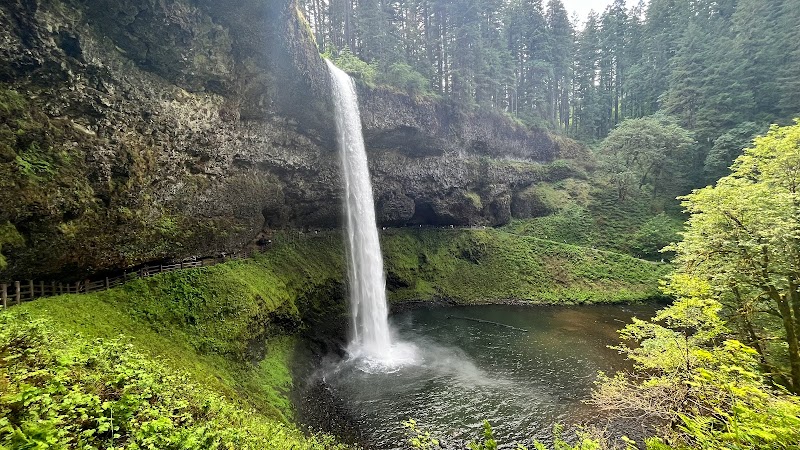
Experience the North Santiam River Fall Run Tournament in Gates, Oregon, where the rush of spawning salmon challenges anglers and nature fans alike. This autumn river event offers a vibrant mix of wildlife, forest trails, and the raw pulse of water in motion, perfect for adventurers ready to engage with Oregon’s fierce river currents.
Wear Grippy Waterproof Footwear
The riverbanks and gravel bars can be slippery. Sturdy boots with firm soles help maintain footing during fishing and hiking.
Pack Layered Clothing
Morning chills and variable fall weather require layering—start with moisture-wicking base layers, add insulation, and finish with a waterproof shell.
Bring Polarized Sunglasses
Glare from the river surface can obscure fish and create eye strain; polarized lenses improve visibility and protect your eyes.
Stay Hydrated and Energized
The exertion of hiking and fishing in cooler fall air masks dehydration risk. Carry water and snacks to maintain energy and focus.
Chasing Currents: The North Santiam River Fall Run Tournament in Gates, Oregon
Each autumn, the North Santiam River near Gates, Oregon, transforms into a compelling arena where anglers test their mettle against the rushing waters in the Fall Run Tournament. The river, alive and insistent, dares you to read its currents, to chase the silver flash of migrating salmon pushing upriver against an unyielding pull. This event is not just a competition—it's an engagement with a river fiercely itself. The tournament spans roughly 15 miles along accessible stretches of riverbank and forest trails, threading through dense stands of Douglas firs and western red cedars standing tall like watchful guardians.
For those attending or participating, the terrain offers a mix of gravel bars, gentle slopes, and moderate elevation changes—approximately 200 feet over the main access trails—making it approachable for a broad range of fitness levels. The river's pulse is constant. You’ll hear its calls—the splash of salmon breaking the surface, the chatter of nearby ospreys circling overhead, and the whisper of wind through the canopy.
Plan your visit for early October through mid-November when the salmon run peaks. Mornings can be crisp, pushing into cool but comfortable afternoons. The river’s edge often glistens with morning frost; evenings require sturdy layers and good waterproof boots. Hydration is critical: the exertion of wading, standing, and trekking in this rugged environment demands a steady flow of fluids. Footwear should grip gravel and slippery rocks alike, so lace up boots with firm soles.
The tournament environment encourages a practical relationship with nature. The North Santiam’s currents push back, reminding anglers and spectators alike that respect is key. Dredging through fishing licenses, reviewing local regulations, and packing essentials like polarized sunglasses can make the difference between a lucky catch and a wasted day on the bank.
Beyond the fishing itself, the surroundings offer quiet moments to observe the river’s restless edge: fallen logs slick with moss, the occasional deer crossing, and the echo of rapids short and sharp. For photographers, dawn and dusk light paint the river and riparian foliage in warm amber hues, creating crisp contrasts perfect for capturing both intimate details and vast landscapes.
Whether you're here for a brief day visit or full tournament involvement, engaging with this river means embracing both its challenge and its rhythms. The North Santiam Fall Run Tournament isn’t just a test of fishing skill—it’s a practical escape into an Oregon river that remains staunchly wild, welcoming, and fiercely alive.
Nearby Trips
All Adventures
Boat Charters
Water Activities
Adventures near Gates, Oregon
Discover the unique and memorable adventures that make Gates, Oregon special.
Frequently Asked Questions
What permits do I need to participate in the Fall Run Tournament?
Anglers must have a valid Oregon fishing license and a Columbia River Basin Endorsement during the tournament period. Check with Oregon Department of Fish and Wildlife for current regulations before your visit.
Are there designated fishing zones along the North Santiam River?
Yes, specific stretches are designated for tournament fishing, with clear boundaries to ensure safety and sustainability. Maps are available at Gates Ranger Station and online.
What wildlife might I encounter during the tournament?
Expect to see bald eagles and ospreys hunting salmon, river otters playing near the water’s edge, and occasional sightings of black-tailed deer in surrounding forests.
Is the river safe for wading during the tournament?
Wading is common but requires caution—currents can be strong, especially near rapids and riffles. Use a wading staff, wear proper boots, and never wade alone.
Are there camping options near the tournament area?
Several campgrounds within nearby Santiam State Forest offer tent and RV camping. Advance reservations are recommended during peak fall season.
What are the best times of day for fishing and photography?
Early morning and late afternoon provide calmer waters, better fish activity, and dynamic lighting for photography, capturing the river’s textures and the salmon’s movement.
Recommended Gear
Waterproof Hiking Boots
Protects feet from wet and rocky terrain, prevents slips and exposure to cold.
Polarized Sunglasses
Reduces glare for safer and more effective fishing and photography.
Layered Clothing
Helps manage temperature changes between chilly mornings and warmer afternoons.
Hydration System or Bottles
Maintains hydration levels during active hours spent on trails and riverbanks.
Local Insights
Hidden Gems
- "East Fork North Santiam River tributaries offer quieter fishing spots and less crowded trails."
- "Opal Creek Heritage Trail, accessible nearby, reveals pristine old-growth forest and crystal-clear springs."
Wildlife
- "Bald eagles soar overhead, especially when salmon numbers peak."
- "River otters frequently surface around calmer pools and bends."
History
"The North Santiam River corridor holds deep cultural significance for the Kalapuya and Molalla tribes, whose ancestral fishing practices continue to influence conservation efforts today."
